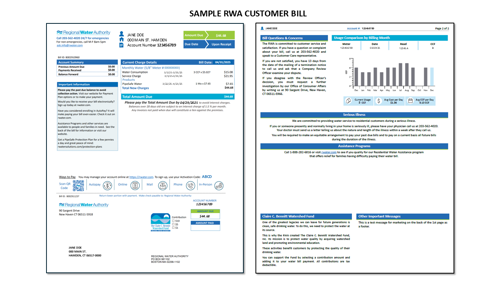In April 2025, we introduced a redesigned bill to make it easier to find the information you need to know about your account and to help you understand the charges on it. Below is an example of a monthly bill, which is now being sent to customers. If you need additional help understanding your bill, please contact us.
Click Here for a Guide to Your RWA Bill (.pdf)
Charges on Your Water Bill
Your water bill is made up of a Service Charge and a Water Consumption Charge (also called "Usage Charge"). The Service Charge for the average residential customer represents 34% of the water bill with the Water Consumption Charge accounting for the remaining 66%.
The Service Charge covers costs to bring water to your home so it's there any time you turn on a faucet. It includes costs such as metering, billing, accounting, customer assistance and information. It's a fixed charge, meaning it won't change on a month-to-month basis.
The Water Consumption Charge varies depending on how much water you have used in the preceding billing period. If you use less water, your usage charge will be lower. If you use more water, your usage charge will be higher. You're billed per CCF (100 cubic feet) of water usage; both the CCF consumed and the rate are shown in the Current Charge Details section of your bill.
If you are enrolled in the PipeSafe emergency protection water and/or sewer/septic repair programs, you will see these charges in the Current Charge Details area of your bill.
If you want to dispute a charge on your bill, you should contact our Customer Care team at 203-562-4020 or email ask.billing@rwater.com.
Other Information on Your Bill
Your bill contains important information about your account and water service, including how to apply for Residential Water Assistance, how to dispute your bill and how to avoid having your water shut off for a past-due balance if someone in your household is seriously ill. It includes helpful information about ways to pay your bill and pipeline protection. It also includes an option to make a contribution to the Claire C. Bennitt Watershed Fund, which supports water quality in the region by acquiring watershed land and promoting environmental protection.



